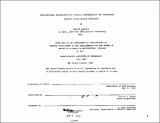| dc.contributor.advisor | Harvey J. Bryan. | en_US |
| dc.contributor.author | Alberto, Donald | en_US |
| dc.contributor.other | Massachusetts Institute of Technology. Dept. of Architecture. | en_US |
| dc.date.accessioned | 2011-05-23T17:42:09Z | |
| dc.date.available | 2011-05-23T17:42:09Z | |
| dc.date.copyright | 1982 | en_US |
| dc.date.issued | 1982 | en_US |
| dc.identifier.uri | http://hdl.handle.net/1721.1/62892 | |
| dc.description | Thesis (M.S.)--Massachusetts Institute of Technology, Dept. of Architecture, 1982. | en_US |
| dc.description | MICROFICHE COPY AVAILABLE IN ARCHIVES AND ROTCH. | en_US |
| dc.description | Bibliography: p. 104-109. | en_US |
| dc.description.abstract | There are two distinguishable parts to this thesis. Part I is a discourse on architectural representation. It defines the theoretical boundary for Part II, research on a particular spatial representation system, physical models, and their use as a design aid. In Part I, representation is discussed as it pertains to the design process. An opinion is built around the excessive 'visual' nature of the topic. The many types of representation systems are described. Finally, a brief historical survey, as well as two current design processes provide insight into applications of these systems. Part II is the documentation of a research project that attempts to visualize physical phenomena (energy behavior) as they act on physical models representative of architectural form. A statement is put forth postulating a design approach that addresses energy behavior in a 'qualitative' sense based on its comprehension through these established visualization techniques. A procedure for testing physical phenomena on models is described and finally, the documentation of such tests for wind, solar shading, convection and light are presented. A conclusion forecasts potential applications of this research. The multi-disciplinary exploration of visual communications and energy conscious design is addressed in the content, as well as the communicative technique and medium of this presentation. The author is responsible for reproducing all the images in this book. Reproductions from other sources were copied photographically. In its original form several pages were printed in offset. This process was completed entirely by the author, from original photograph to pasteup, printing preparation and running the press. An experimental video production is being prepared as well. | en_US |
| dc.description.statementofresponsibility | by Donald Alberto. | en_US |
| dc.format.extent | 110 p. | en_US |
| dc.language.iso | eng | en_US |
| dc.publisher | Massachusetts Institute of Technology | en_US |
| dc.rights | M.I.T. theses are protected by
copyright. They may be viewed from this source for any purpose, but
reproduction or distribution in any format is prohibited without written
permission. See provided URL for inquiries about permission. | en_US |
| dc.rights.uri | http://dspace.mit.edu/handle/1721.1/7582 | en_US |
| dc.subject | Architecture. | en_US |
| dc.subject.lcsh | Communication in architectural design | en_US |
| dc.subject.lcsh | Architecture and energy conservation | en_US |
| dc.subject.lcsh | Architectural rendering | en_US |
| dc.title | Architectural representation ; spatial comprehension and assessment through visualization technique | en_US |
| dc.type | Thesis | en_US |
| dc.description.degree | M.S. | en_US |
| dc.contributor.department | Massachusetts Institute of Technology. Department of Architecture | |
| dc.identifier.oclc | 08995766 | en_US |
